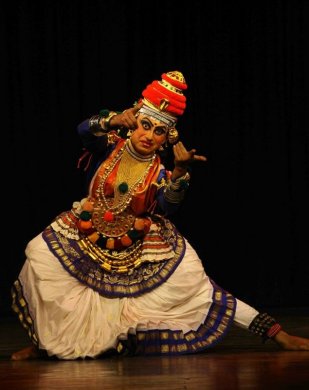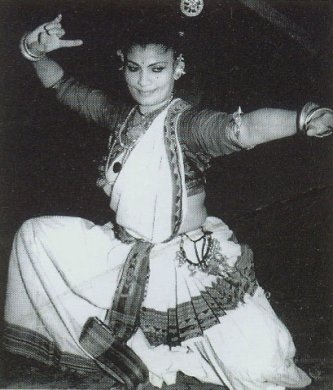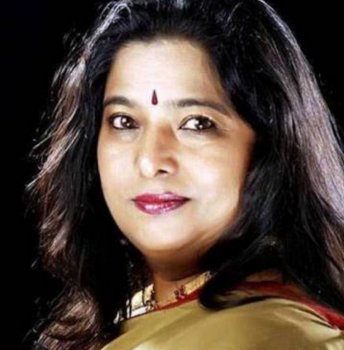
|   |

|   |
 e-mail: leelakaverivenkat@gmail.com Stree vesham and a stree without parallel September 13, 2020 Exalted evening of Shakespearean classics inspired Kathakali stree vesham The inspiration behind the elegantly organised Kathakali event by the National Institute of Advanced Studies in Bangalore, was a book on Stree Vesham in Kathakali (Shubhi Publication) by exponent Prabal Gupta, dedicated to two famous people in the world of dance who changed his career - the most important being his Guru Sadanam P. V Balakrishnan, groomed under stalwarts like Kalluvazhi Ittirarissa Menon Asan, Pattikamtodi Ravunni Menon and the eminent teacher, innovator whom the guru regards as his role model for life namely, Keezhpadam Kumaran Nair Asan. The second person is Mohiniattam dancer/guru Bharati Shivaji who as Prabal's first dance mentor was instrumental in steering his aptitude for lasya oriented dance towards stree vesham in Kathakali for which she deemed he was a more suitable candidate. The evening projecting Kathakali stree vesham built round two heroines, Cleopatra and Lady Macbeth, comprised cultural crossovers transcending regional boundaries in more ways than one - with English Shakespearean classics inspiring female characters, visualised in the highly stylised idiom of Kathakali from Kerala, and rendered by a Calcutta-born Prabal Gupta who has worked hard at making this dance theatre form his art expression. Shakespeare's characters in their large dimensions provide excellent material and inspiration for Kathakali which delights in its epic proportioned character types of heroes and heroines. But these figures, because of their place in dramatic literature, would seem to have acquired, in the course of hundreds of portrayals through different art genres, a certain baggage fitting into a mould allowing (unlike even well known epic characters dealt with in literature in several languages with each having a special interpretation) minimal freedom to play around and experiment with. And when the inspired version belongs to an entirely different cultural genre, to preserve the stylisation of the translated idiom while not distorting the original copy, is a huge challenge. So while the created version demands its own intrinsic worth to exist, these translations cannot depart too far from the original inspiring them. Prabal's untiring efforts at mastering what the Guru's creative genius visualised made for a rewarding evening. 'The Bard and the Beautiful' as the evening was titled was based on an excellent foundation of a simple but very appropriate Sanskrit script and 'attakatha' by Dr. Shankar Rajaram, who obviously is familiar with Shakespeare's version. Next was the sensitive music under Guru Sadanam Balakrishnan's guidance, with vibrant vocal support by Sadanam Sivadasan and Sadanam Babu whose mellifluous voices along with chenda and edakka by Sadanam Ramakrishnan created magic.  Prabal Gupta as Cleopatra Costume aesthetic was yet another factor. In blue and white, with a Koodiyattam crown, resplendently turned out Prabal looked every inch the Pharaoh Cleopatra. Even the print on the white of the garment was different evoking an Egyptian flavour. Starting with the nectarine tones of love in Shankarabharanam, "Kutra kutrasthi sakhi mama vallabha" Cleopatra enters, asking for the whereabouts of her loved one Antony. In the second part set to Purvikalyani ragam, Alexa gifts Cleopatra with Antony's gift, a pearl, and Cleopatra in poetic fashion, using the collyrium applied in Alexa's eyes, decides to pen a love letter to her lover ('snehena vitarati sa moutikavaram, visruvjami tasmai swa lekhanakaram'). Cleopatra wonders if Antony is now walking, climbing or riding in valour - the one who endearingly calls her the 'Serpent of the blue waters of the Nile' (Kimut nila nadi, naagiti maam sambodhya sambodhya tushyati tamaam) - the snake motif specially applying to Cleopatra whose chosen end too was through a snake bite. A vastly evolved dancer, Prabal since I last saw him about half a dozen years back, epitomised grace and conviction - Shakespeare's version very evident in the Kathakali stree vesham stylisation, wherein text and sub-text were evocatively brought out. In a contrasting black character of Lady Macbeth, again the music in Shanmukhapriya, Sindhubhairavi and finally Madhyamawati gave a perfect emotive starting point, with the script by Shankar Rajaram equally evocative. Lady Macbeth's soliloquy calling upon evil forces to possess her so as to crush all the human kindness of soft feminine nature, "Maam upayath samasta bhoota… Nashyata stree sahajaam mridutam hridi karunabharite" set to Shanmukhapriya in Chempada talam is followed by the determination to fulfil the deed of killing Duncan with (her husband and she) their own hands as she passes on the dagger to Macbeth "sundara samhara narapaalam kuru nija haste karavalam" sung in Sindhubhairavi to the final sleep walking scene in Madhyamawati clearly etching Shakespeare's images of Lady Macbeth's endlessly convulsed hands trying to cleanse the blood (who would have thought an old man had so much blood!) with even the exotic perfumes of Arabia unable to eradicate that taint. Prabal's abhinaya had all the intensity, in first conveying the determination to perform the terrible deed, after which came the scene of the sleep walking heroine in the tumult of her guilt-ridden agony. What was interesting in the choreography was to see how the kalasams or rhythmic punctuations between passages gradually changed from the feminine tone to one approximating the masculine kalasam in keeping with the manner in which Lady Macbeth shed her femininity to adorn a more aggressive male attitude. A well structured programme by Sangeetha Menon and her group of Institute helpers, the crowning glory for the performer Prabal was in the Guru's acknowledgement that though not born to the Kathakali region, his student, despite doubts in the Guru's mind about how the regional divide could be covered, had succeeded in demonstrating what hard work and zeal in a difficult art form like Kathakali could achieve and hence deserved all encouragement and praise. The dancer is working on more plans and his Guru Sadanam Balakrishnan while wedded to tradition, is one whose creative passion thrives on challenges. Remembering the dance legend Shanta Rao  Shanta Rao A 'formidable lady' in more senses than one, Shanta Rao was one of those rare dancers, who will never have a second to equal her. And yet, but for the book Dances of the Golden Hall authored by Ashoke Chatterjee and a clutch of extraordinary photographs of her by Sunil Janah, images of this dancer, who lived in her own private world and whose magnetic almost masculine energy in dancing became a byword in the lasya immersed Mohiniattam world, would have been totally unknown. Great minds were arrested by the electric quality of her dance. Yehudi Menuhin wrote about "the power and grace of her beautiful movements" while late Prime Minister Indira Gandhi herself penned in her introduction to Ashoke Chatterjee's book, "Shanta Rao brings an intensity to dance. Vivacious and full of energy, she reminds us of one who swims out to meet the waves…." and late Vallathol Narayana Menon when greeting Shanta at Trichur permitting her to be the first woman to be accepted as student in Kerala Kalamandalam is said to have remarked, "You will soon be the number one dancer of India". Pressmen abroad who had occasion to watch her dance raved about the striking nature of her dance. The 'Remembering Shanta Rao' evening sponsored by Jaywant Naidu of Hyderabad, along with participant Sunil Kothari (the only critic who had interactions with Shanta Rao), had for me some interesting bits of information revealed by the second participant, namely Kuchipudi exponent Veena Murthy Vijay of Bangalore, who, while no student of Shanta Rao, had a peculiar closeness to her. Calling Shanta Rao her 'Manasik Guru' because she had earned and enjoyed the privilege of watching her rehearse every day, from the narrow windows of her home in Brigade House, Bangalore, she explained how Shanta had steadfastly refused to teach and train anybody and not even Veena's friend Gita, daughter of an Income tax Commissioner, very friendly with Shanta, was obliged - when the father quietly broached the subject of his daughter learning from Shanta. "Ninnage yatikke dance?" (Why do you need dance?), she asked her. "You will get married and then give it up like all others.") And this remained her attitude. As a matter of fact, as pointed out by Sunil Kothari, Shanta did not like the idea of even her guru like Vempati Chinna Satyam who taught her for some time, taking on other students, on which point the teacher/student association finally broke up.  Veena Murthy Vijay Veena gave a vibrant description of Shanta's arresting personality with her huge eyes, her fashion of the high side bun with a hibiscus decorating it - one ear only turned out in heavy jhumka earring, plus the striking ruby pendant necklace. This unusual artist whose friends were persons like T.R. Mahalingam, the flute wizard and critic S.N. Chandrasekhar, was not easy to approach and she did not welcome all and sundry visiting her. Veena Murthy's Kuchipudi Guru Korada Narasimha Rao wanted her to present Bhama Kalapam (as she had learnt it) in front of Shanta Rao, who was famous for her Bhama Nrityam. Shanta's words after that evening of a formal performance was that she was 'fairly pleased by your practice' - considered high praise and thereafter she allowed Veena to enter her house. Veena's neighbour happened to be Shanta's vocalist, and when she went for rehearsals to Shanta's place, her two sons stayed in Veena's house. Her orchestra, all on pay rolls, was always ready. She mentioned Srinivas Murthy as the violinist. Veena animatedly described Shanta's passion for creativity, particularly her painting. Her phenomenal commitment to dance, and the desire often expressed to be born a dancer in every birth was exhibited in her rigorous daily practice with the entire regiment of Kathakali exercises plus innumerable exercises of sitting and jumping in muzhumandi. Shanta's alarippu (a video was screened) was famous for her leaps and jumps, and Veena explained how while seated in muzhumandi executing a mandi adavu, instead of slowly rising retaining that position, she would bring the knees together and rise without the kshipta knee bend and then go on to the next step. Veena said only two dancers, guru Padmini Ramachandran and Yamini Krishnamurthy, had used in their respective dance, similar leaps and jumps. Veena was ecstatic while talking of Shanta Rao's poses caught on Sunil Janah's camera. Shanta believed she was the best - and she gave herself up fully to each moment of her performance. And indeed every frozen moment captured of her dance spoke powerfully. Watching those photographs of Sunil Janah on the screen, one felt that each stance showed its most exalted possibility, beyond which there was nothing.  Writing on the dance scene for the last forty years, Leela Venkataraman's incisive comments on performances of all dance forms, participation in dance discussions both in India and abroad, and as a regular contributor to Hindu Friday Review, journals like Sruti and Nartanam, makes her voice respected for its balanced critiquing. She is the author of several books like Indian Classical dance: Tradition in Transition, Classical Dance in India and Indian Classical dance: The Renaissance and Beyond. Post your comments Please provide your name and email id when you use the Anonymous profile in the blog to post a comment. All appropriate comments posted with name and email id in the blog will also be featured in the site. |